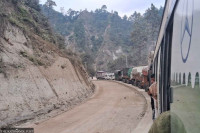Editorial
Spreading menace
Upgrading our understanding of diseases and disasters is crucial to meet the challenges of a changing climate.
Historically, snakebite was considered a major problem only in the southern parts of the country, with poisonous snakes mostly inhabiting areas with high temperatures. Our institutional infrastructures, public understanding, traditional knowledge and various other setups were accordingly structured. But things have changed significantly. High death toll by snakebite formerly seen in southern parts is being replicated not only in the mid-hills but also in mountainous districts like Sindhupalchowk.
Sixteen of the 31 patients admitted to the Sukraraj Tropical and Infectious Disease Hospital on Sunday were rushed there after being bitten by snakes of various kinds. Doctors at the hospital say eight to ten snakebite victims seek treatment there every day, and most victims seeking medication at the hospital are from the districts of Kathmandu Valley or from those adjoining the Valley. Until a decade ago, the hospital hardly saw any snakebite cases from these areas. Last month, people from Sindhupalchowk rushed a man to the hospital to treat a snakebite. He was bitten by a king cobra. According to doctors, the number of patients coming to the hospital from neighbouring districts after being bitten by venomous snakes has significantly increased. This shows deadly snakes like cobras have climbed up not only hills but also into mountainous districts.
Mosquitoes, which were also considered a problem of the plains until a few decades ago, have already become a common nuisance for all hill districts. These insects have even reached the high mountainous districts such as Mustang, often hidden among the goods transported there from lowlands. Dengue, a mosquito-borne disease, has become endemic in Nepal for the past couple of years. Infection and mortality from it has spiked alarmingly. This year, most districts have already reported dengue cases at the start of the monsoon, even as the post-monsoon period is considered conducive for disease transmission. Last year saw the death of at least 20 persons and infection of over 52,000 by the virus as it spread to all 77 districts of the country.
Not only insects, even wild animals including leopards, tigers and other predators have surprised people by appearing in the highlands, where they were considered non-existent. Besides this, extreme weather events and incidents of disasters have become more frequent thanks to the impact of global warming. So the central factor responsible for these shifts is climate change. Global warming has brought seismic changes in this Himalayan country. But our authorities still seem to be in a slumber when it comes to tackling the new pattern of crises and diseases.
It has become urgent to upgrade Nepali authorities’ understanding about diseases and disasters. Then, our institutional setups need a revamp based on the changed context. For instance, traditionally, hospitals in the hills were not supposed to see a high number of snakebite patients. But things have changed a lot. Now, the health facilities may need a sufficient number of anti-venom vials as well as new training for medical staff there. There are enough indications that our institutions and human resources need to be prepared for truly unprecedented circumstances.




 6°C Kathmandu
6°C Kathmandu














